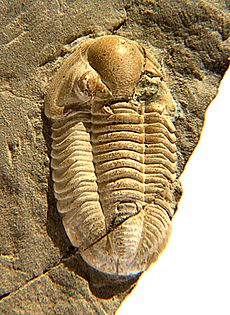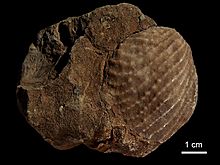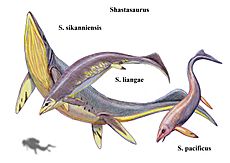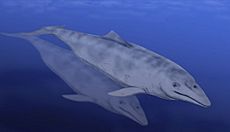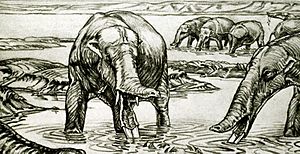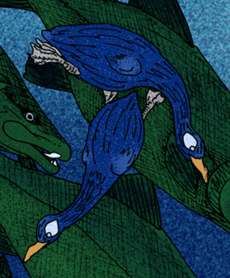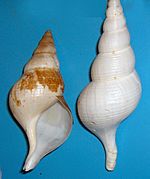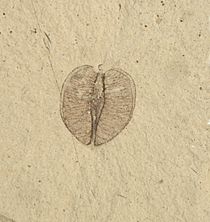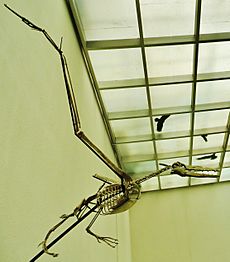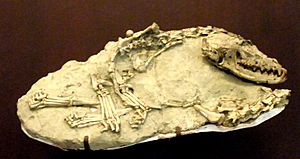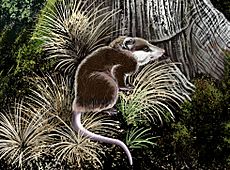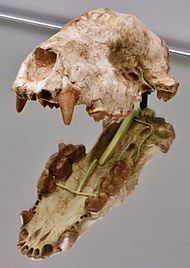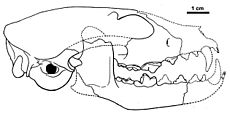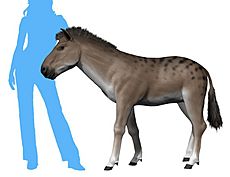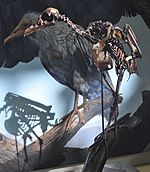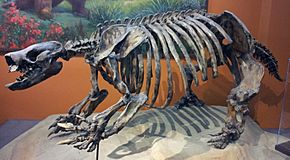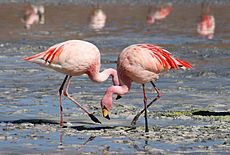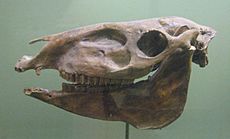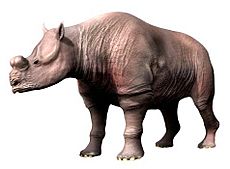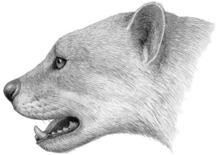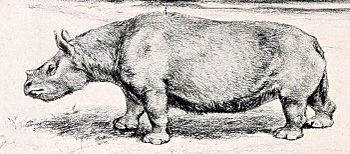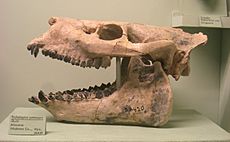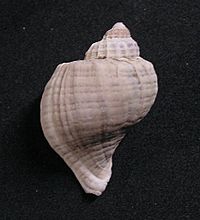List of the prehistoric life of Oregon facts for kids
This article is about the amazing ancient life forms whose fossils have been found in the US state of Oregon. Imagine a time long, long ago when different creatures roamed the land and swam in the seas of what is now Oregon! Paleontologists (scientists who study fossils) have discovered many clues about these ancient inhabitants.
Contents
Precambrian Era: No Life Yet!
The Paleobiology Database tells us that no fossils from the Precambrian era have been found in Oregon. This means that during that incredibly early time, Oregon was likely still forming, or conditions weren't right for preserving any simple life that might have existed.
Paleozoic Era: Ancient Sea Creatures
The Paleozoic Era was a time when many different kinds of sea creatures lived. Oregon was mostly covered by warm, shallow seas back then. Scientists have found fossils of many interesting animals from this period, including:
- Brachiopods: These were shelled creatures that looked a bit like clams, but they are actually a different group of animals. They lived attached to the seafloor.
- Trilobites: These ancient arthropods (like modern crabs or insects) had segmented bodies and hard shells. They crawled along the seafloor or swam.
- Corals: Just like today, ancient corals built reefs in the warm seas.
- Chitons: These are a type of mollusk with eight shell plates on their backs.
Here are some examples of the types of creatures found:
- †Acteonina
- †Albaillella
- †Alexenia
- †Anidanthus
- †Antiquatonia
- †Arceodomus
- †Arcochiton
- †Bajkuria
- †Bathymyonia
- †Calliprotonia
- †Changmeia
- †Chauliochiton
- †Chonetes
- †Chonetinella
- †Cleiothyridina
- †Composita
- †Corwenia
- †Crurithyris
- †Cummingella
- †Cystolonsdaleia
- †Deflandrella
- †Derbyia
- †Diadeloplax
- †Dielasma
- †Entactinia
- †Entactinosphaera
- †Eoparafusulina
- †Follicucullus
- †Gryphochiton
- †Haplentactinia
- †Hegleria
- †Heritschioides
- †Himathyris
- †Homeochiton
- †Hustedia
- †Ishigaum
- †Kashiwara
- †Kleopatrina
- †Kochiproductus
- †Krotovia
- †Kuvelousia
- †Latentibifistula
- †Latentifistula
- †Leptodus
- †Linoproductus
- †Marginifera
- †Martinia
- †Meekella
- †Monodiexodina
- †Nazarovella
- †Neoalbaillella
- †Neospirifer
- †Petalaxis
- †Polydiexodina
- †Praedeflandrella
- †Probolionia
- †Proboscidella
- †Protowentzelella
- †Pseudoalbaillella
- †Pseudotormentus
- †Pterochiton
- †Punctospirifer
- †Quinqueremis
- †Rhipidomella
- †Rhynchopora
- †Rostranteris
- †Schwagerina
- †Siphonodendron
- †Spiriferella
- †Spiriferellina
- †Stenoscisma
- †Stigmosphaerostylus
- †Tiramnia
- †Triplanospongos
- †Waagenoconcha
- †Wellerella
- †Wilsonastraea
- †Yakovlevia
- †Yokoyamaella
Mesozoic Era: Dinosaurs and Marine Reptiles
The Mesozoic Era is often called the "Age of Dinosaurs," but in Oregon, many fossils from this time are of marine (sea) creatures. This is because much of Oregon was still underwater during parts of the Mesozoic.
Amazing Marine Reptiles
- Ichthyosaurs: These were giant marine reptiles that looked a lot like dolphins or sharks. They were fast swimmers and top predators in the ancient oceans.
- One famous ichthyosaur found in Oregon is Shastasaurus.
- Ammonites: These were shelled creatures related to modern-day squids and octopuses. Their coiled shells are very common fossils.
- Bivalves: These are like modern clams and oysters, with two hinged shells.
- Giant bivalves like Inoceramus lived in Oregon's ancient seas.
Other Mesozoic Life
- Conodonts: These were tiny, eel-like creatures with strange tooth-like structures.
- Plants: While marine life was common, some plant fossils have also been found, showing what the land might have looked like.
Here are some of the fascinating creatures and plants from Oregon's Mesozoic Era:
- †Acanthodiscus
- †Actinoceramus
- †Anahamulina
- †Anatropites
- †Arcestes
- †Arietoceltites
- Astarte
- †Bennettazhia
- Cadulus
- †Calycoceras
- Cardinia
- †Cenoceras
- Chlamys
- †Cleoniceras
- †Corum
- †Crioceratites
- Dentalium
- †Gervillia
- †Gryphaea
- †Hoploparia
- †Hypophylloceras
- †Inoceramus
- †Kilianella
- †Lantus
- Lima
- †Lissodus
- † Loffa
- Lopha
- †Lucina
- †Lyelliceras
- †Lytoceras
- †Mantelliceras
- †Metapolygnathus
- Milax
- †Modiolus
- †Myophorella
- †Neogondolella
- †Nerinea
- †Olcostephanus
- †Ophthalmidium
- Ostrea
- †Otoscaphites
- †Pachus
- †Pachydiscus
- †Peronidella
- Pholadomya
- †Phylloceras
- †Phyllopachyceras
- †Plagiostoma
- †Platymya
- Plicatula
- †Radium
- †Scalarites
- †Scaphites
- †Shastasaurus
- †Spitidiscus
- †Thamnasteria
- †Tragodesmoceras
- †Trigonia
- Turritella
- †Tutcheria
- Venericardia
- †Vermiceras
- †Xiphotheca
- †Zoneait
Cenozoic Era: Mammals Take Over
The Cenozoic Era is often called the "Age of Mammals" because mammals became very common and diverse after the dinosaurs disappeared. Oregon's landscape changed a lot during this time, from warm, swampy forests to cooler, drier plains.
Ancient Mammals of Oregon
- Horses: Many different types of ancient horses lived in Oregon, from small, three-toed horses to larger, more modern-looking ones.
- Examples include †Acritohippus, †Merychippus, and †Pliohippus.
- Camels: Yes, ancient camels lived in Oregon! They were different from the camels we see today.
- One type was †Camelops.
- Elephants and their relatives: Huge elephant-like creatures, such as †Gomphotherium and †Mammuthus columbi (the Columbian mammoth), roamed Oregon.
- Dogs and Cats: Ancient dog-like animals like †Borophagus (bone-crushing dogs) and saber-toothed cats like †Dinictis and †Machairodus hunted in Oregon.
- Rhinos: Prehistoric rhinoceroses, like †Teleoceras, also lived here.
- Sloths: Giant ground sloths, such as †Paramylodon, were much larger than today's sloths and lived on the ground.
- Bears: Early bears, like †Indarctos, have been found.
- Beavers: Ancient beavers, including †Palaeocastor, built their homes in Oregon's waterways.
Birds and Marine Life
- Birds: Many types of birds, including ducks, geese, and even flamingos, have left their fossilized remains in Oregon.
- Examples include †Aechmophorus (grebes) and †Phoenicopterus (flamingos).
- Marine Mammals: As parts of Oregon were still coastal, fossils of ancient whales, seals, and sea lions have been found.
- †Aetiocetus was an early baleen whale, and †Enaliarctos was an early seal.
- Fish and Sharks: Fossils of fish and sharks, like †Isurus (a type of mackerel shark), show that Oregon's waters were full of life.
Ancient Plants of Oregon
Oregon's plant life also changed a lot during the Cenozoic. Fossils show a variety of trees and plants, from ancient redwood relatives to flowering plants.
- Trees: Many familiar trees like Acer (maple), Alnus (alder), Fagus (beech), Quercus (oak), and Sequoia (redwood) have fossil records in Oregon.
- Flowering Plants: Fossils of flowering plants like Florissantia and Craigia show the diversity of ancient flora.
Here are some of the many Cenozoic life forms found in Oregon:
- Abies
- †Acamptogenotia
- Acanthocardia
- Acer
- Acmaea
- †Acritohippus
- Acteon
- †Actinidia
- Admete
- Aechmophorus
- †Aesculus
- †Aetiocetus
- Aforia
- Agelaius
- †Agriochoerus
- Aix
- Alangium
- Alnus
- †Amebelodon
- Amelanchier
- Ammospermophilus
- Ampelocissus
- †Amphicyon
- Amphissa
- †Ampullina
- †Anabernicula
- Anadara
- †Anamirta
- Anas
-
†Anas clypeata
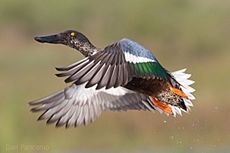 A living Spatula clypeata, or northern shoveler
A living Spatula clypeata, or northern shoveler - Ancilla
- Anona
- Anser
- Antillophos
- Antilocapra
- Aphananthe
- †Aphelops
- Aquila
- Arbacia
- †Archaeocyon
- †Archaeohippus
- †Archaeotherium
- Architectonica
- †Arctodus
- Ardea
- Argobuccinum
- †Ascosphaera
- Astraea
- Astreopora
- Astropecten
- †Aturia
- †Aucuba
- Aythya
- Balaena
- Balaenoptera
-
†Balaenoptera acutorostrata
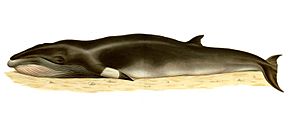 Illustration of a living Balaenoptera acutorostrata, or common minke whale
Illustration of a living Balaenoptera acutorostrata, or common minke whale - Balanophyllia
- Balanus
- Bartramia
- †Basirepomys
- Bathybembix
- Bathytoma
- Bela
- Betula
- Bittium
- †Bonellitia
- Boreotrophon
-
†Borophagus
 Restoration of two of the Miocene-Pliocene bone-crushing dog genus Borophagus preying on a camel. Jay Matternes (1964).
Restoration of two of the Miocene-Pliocene bone-crushing dog genus Borophagus preying on a camel. Jay Matternes (1964). - Botaurus
- Brachidontes
- Branta
- Bubo
- Buccinum
- Bullia
- †Bumelia
- Cadulus
- Calliostoma
- Callista
- Callorhinus
- †Calocedrus
- †Calycocarpum
- Calyptraea
-
†Camelops
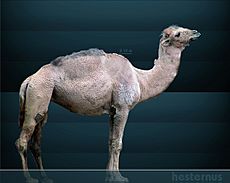 Life restoration of the Pliocene-Holocene camel Camelops
Life restoration of the Pliocene-Holocene camel Camelops - Cancellaria
- Canis
- †Carpocyon
- Carya
- Caryophyllia
- Castanea
- Castanopsis
-
Castor
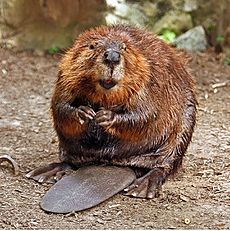 A living Castor canadensis, or North American beaver
A living Castor canadensis, or North American beaver - †Catalpa
- Cedrela
- Celtis
- †Centrocercus
- Cercidiphyllum
- Cercis
- Cerithiopsis
- †Charitonetta
- Chen
- †Chendytes
- Chione
- Chlidonias
- Chlorostoma
- †Choerodon
- †Chrysodomus
- Circus
- Cladrastis
- Clangula
- Cleyera
- Clinocardium
- Cochliolepis
- Colaptes
- †Colodon
- Columbella
- Colus
- Comitas
- Comptonia
- Conomitra
- Conus
- †Cophocetus
- Corbula
- †Cormocyon
- Cornus
- †Cornwallius
- Corvus
- †Coryloides
- Craigia
- Crataegus
- Crenella
- Crepidula
- Cryptonatica
- Cryptotis
- †Cunninghamia
- Cyclocardia
- Cygnus
- Cymatium
- †Cynarctoides
- †Cynelos
- †Daeodon
- †Dafila acuta
- †Daphoenodon
- †Daphoenus
- †Dasornis
- Decodon
- Dendragapus
- Dentalium
- †Desmatippus
- †Desmatochoerus
- †Desmatophoca
- †Desmocyon
- †Desmostylus
- †Diceratherium
- †Dilophodelphis
- †Dinaelurus
- †Dinictis
- †Diploporus
- †Dipoides
- †Diprionomys
- Dipteronia
- Discinisca
- Dosinia
- †Dromomeryx
- †Dyticonastis
- Echinophoria
- †Ekgmowechashala
- †Emmenopterys
- †Enaliarctos
- Engelhardtia
- Enhydra
- †Enhydrocyon
- †Ensete
- †Epicyon
- †Epihippus
- Epitonium
- †Eporeodon
- †Equisetum
- Equus
- †Erismatura jamaicensis
- Erolia
- Ervilia
- †Eucastor
- †Eucyon
- †Euoplocyon
- Euphagus
- Euspira
- †Eutrephoceras
- Exbucklandia
- †Exilia
- Fagus
- Falco
- Ficus
- Fimbria
- Flabellum
- †Floridaceras
- †Florissantia
- Fothergilla
- Fraxinus
- Fulgoraria
- Fulgurofusus
- Fulica
- Fusinus
- †Gaillardia
- Gari
- Gemmula
- †Gentilicamelus
- Glycymeris
- †Goedertius
-
†Gomphotherium
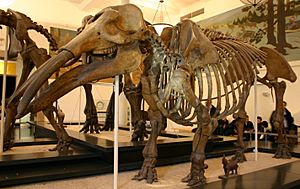 Mounted fossilized skeleton of the Miocene-Pleistocene elephant relative Gomphotherium
Mounted fossilized skeleton of the Miocene-Pleistocene elephant relative Gomphotherium - Granula
- Gyrineum
- †Hadrianus
- Halesia
- Haliaeetus
- †Haplohippus
- †Hemiauchenia
- Heptranchias
- †Herpetotherium
- Hiatella
- Himantopus
- †Hippotherium
- †Hoplophoneus
- †Hovenia
- Hydrangea
- †Hypertragulus
- †Hypohippus
- †Hypolagus
- †Hypsidoris
- †Hypsiops
- †Hyrachyus
- †Indarctos
- Isurus
- Juglans
- †Kalobatippus
- †Kardiasperma
- Kellia
- †Keteleeria
- †Kolponomos
- Lacuna
- Larus
- Lepeta
- †Leptocyon
- Lepus
- Leukoma
- Limnodromus
- Lindera
- Liquidambar
- †Lithocarpus
- Littorina
- Lophodytes
- †Lophortyx
- Lynx
- Lytechinus
- †Machairodus
- †Machilus
- Macoma
- Macrocallista
- Magnolia
- Mahonia
- †Malus
- †Mammut
- †Mammuthus
-
†Mammuthus columbi
 Life restoration of a herd of Mammuthus columbi, or Columbian mammoths. The extent of the fur depicted is hypothetical. Charles R. Knight (1909).
Life restoration of a herd of Mammuthus columbi, or Columbian mammoths. The extent of the fur depicted is hypothetical. Charles R. Knight (1909). - Marcia
- Margarites
- Martes
- Martesia
- Mastixia
- Megachasma
- †Megalonyx
- †Megapaloelodus
- †Megatylopus
- Melanitta
- †Meliosma
- †Menispermum
- Mergus
- †Merychippus
- †Merychyus
- †Merycochoerus
- †Merycoides
- †Merycoidodon
- †Mesocyon
- †Mesohippus
- †Metalopex
- Metasequoia
- †Microphallus
- Microtus
- †Miohippus
- †Miotapirus
- Modiolus
- Molothrus
- †Monosaulax
- †Moropus
- Mulinia
- Mustela
- †Mya
- Myotis
- Mytilus
- †Nanotragulus
- Nassarius
- Natica
- †Nautilus
- Nectandra
- †Neohipparion
- Neophrontops
- Neotamias
- †Neurotrichus
- Neverita
- †Nexuotapirus
- Nucella
- Nucula
- Numenius
- †Nuphar
- †Nyssa
-
Ochotona
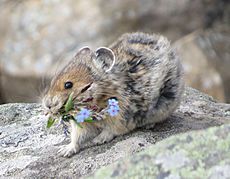 A living Ochotona, or pika
A living Ochotona, or pika - Ocotea
- Olar
- †Oligobunis
- Olivella
- Ondatra
- Opalia
- †Oreodontoides
- †Osbornodon
- †Osmunda
- Ostrea
- Ostrya
- †Palaeocastor
- †Palaeolagus
- †Paleopanax
- Paliurus
- Pandora
- Panopea
- Panthera
- †Paradaphoenus
- †Paraenhydrocyon
- †Parahippus
- †Paramylodon
- †Paratomarctus
- †Paratylopus
- †Paronychomys
- †Paroreodon
- †Parrotia
- †Parthenocissus
- Passalus
- †Patriofelis
- Pekania
-
†Pelagornis
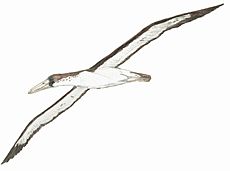 Life restoration of the Oligocene-Pleistocene false-toothed bird Pelagornis
Life restoration of the Oligocene-Pleistocene false-toothed bird Pelagornis - Pelecanus
- Perognathus
- Peromyscus
- †Perse
- Phalacrocorax
- Phalaropus
- Phalium
- Phanerolepida
- †Philotrox
- †Phlaocyon
- Phoca
- Phoenicopterus
- Pinus
- Pitar
- †Plagiolophus
- Platanus
- †Platygonus
- †Pleiolama
- †Plesiocolopirus
- †Plesiogulo
- †Pliocyon
- †Pliohippus
- †Plionarctos
- Podiceps
- Podilymbus
- †Pogonodon
- Polinices
- †Polypodium
- †Pontolis
- †Potamogeton
- †Pristichampsus
- †Procamelus
- †Promartes
- †Promerycochoerus
- Propeamussium
- †Protitanops
- †Protolabis
- Protothaca
- Prunus
- †Psephophorus
- †Pseudaelurus
- †Pseudotsuga
- Pteris
- Pterocarya
- †Pteronarctos
- Puncturella
- Purpura
- Pyramidella
- Pyrenacantha
-
†Pyrus
 Fruit of a living Pyrus, or pear tree
Fruit of a living Pyrus, or pear tree - Quercus
- Querquedula
- Raja
- Rallus
- Recurvirostra
- Retusa
- Rhabdus
- †Rhizocyon
- Rhus
- †Ribes
- Rimella
- Rosa
-
Rubus
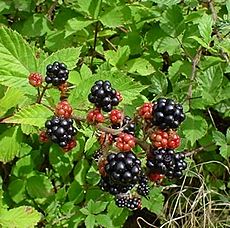 A living member of Rubus, the genus including blackberries (pictured) and raspberries
A living member of Rubus, the genus including blackberries (pictured) and raspberries - Sabal
- †Sabia
- Salix
- Sanguinolaria
- Sassia
- Saxidomus
- Scapanus
- Scaphander
- †Schisandra
- Schizaster
- Sciurus
- †Scutella
- Semele
- Sequoia
- Siliqua
- †Simocetus
- †Simocyon
- Sinum
- Solariella
- Solemya
- Solen
- †Somatochlora
- Spermophilus
- Spirotropis
- Spisula
- Spizaetus
- †Steneofiber
- Stercorarius
- Sterna
- Sthenictis
- Strongylocentrotus
- Sturnella
- †Suavodrillia
- †Subhyracodon
- Sveltella
- Symplocos
- Tapirus
- Tapiscia
- Taranis
- Taxidea
- †Taxus
- Tegula
- †Teleoceras
- Tellina
- †Temnocyon
- †Tephrocyon
- Terminalia
- †Tetraclinis
- Thais
- Thesbia
- Thomomys
- Thracia
- †Ticholeptus
- Tilia
- †Torreya
- Totanus
- †Toxicodendron
- Trema
- Tresus
- Trichotropis
- Trochita
- Trophon
- †Tsuga
- Turricula
- Turris
- Turritella
- †Tylocephalonyx
- Tympanuchus
- Ulmus
- †Ursavus
- Venericardia
- †Viburnum
- Vitis
- Vulpes
- Xema
- Yoldia
- Zalophus
-
†Zalophus californianus
 A living Zalophus californianus, or California sea lion
A living Zalophus californianus, or California sea lion - Zelkova


